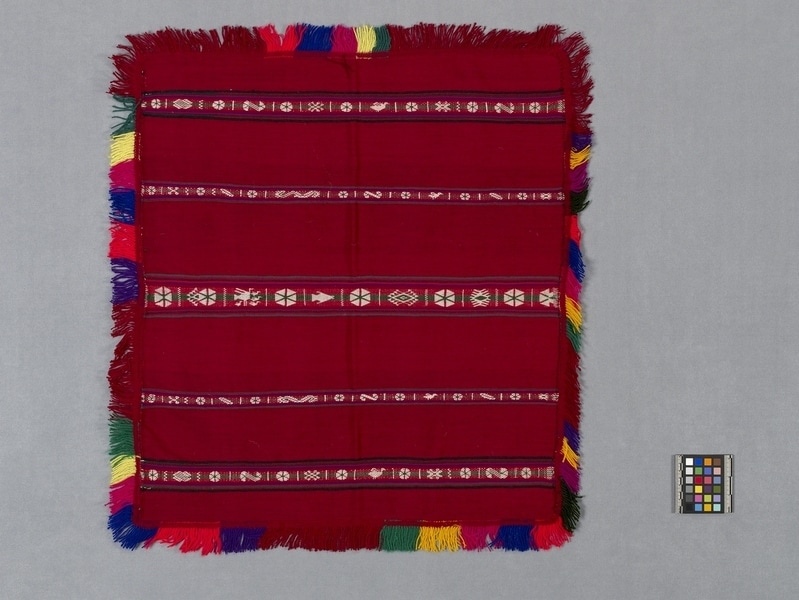Cloth Item Number: Sf915 from the MOA: University of British Columbia


Description
Cloth, rectangular, woven from red wool with three wider and two narrower bands of green and red geometric, fish, and bird figure motifs on off-white. Each band is edged with a series of narrow, brightly coloured stripes.The edge is finished with a multicoloured fringe.
History Of Use
Warp-faced fabrics with three or four selvedges are woven by women but the fabrics the techniques, structures and some of the motifs have pre-Conquest antecedents. This type of textile conveys the most information about an individual's ethnicity, sex, age, status and particular history. Are used by both sexes. Rectangular cloths are pinned to the shoulders or hips of men and women for some fiesta dances, for example, the 24th of June and the Pentecost.
Iconographic Meaning
The range of motifs refers to local geography and landmarks, ecology, fecundity as well as luck. The six part circle refers to the division of land into six sections on Taquile and the rotation of crops and fallow periods. The striated cross represents the raised furrows of a tilled field. The s-shaped reverse curve is generally said to be the boat port.
Cultural Context
fiesta dancing
Narrative
Woven and used by Candelaria Cruz Machaca. One corner of the cloth is folded down and the truncated diamond shape is pinned or sewn to the shoulders.
Specific Techniques
Weave structures are the following: 1-plain colour areas are warp faced plain weave. 2- figurative designs; complementary-warp weave with 3-span floats aligned in alternate pairs with an irregular (abbabaab) warping order (3/1 horizontal colour changes and diagonals of 2-span floats). 3- stripe with squares; float weave derived from turned 2/1 horizontal herringbone with floats forming squares.
Item History
- Made by Candelaria Cruz Machaca (Maker) in Taquile, Puno, Peru during 1978
- Collected by Mary Frame during 1982
- Owned by Mary Frame before February 10, 1983
- Received from Mary Frame (Seller) and Museum of Anthropology Shop Volunteers (Funding source) on February 10, 1983
What
- Name
- Cloth
- Identification Number
- Sf915
- Type of Item
- cloth
- Material
- wool fibre and synthetic fibre
- Manufacturing Technique
- woven, spun, plied, sewn and retwisted
- Overall
- height 73.6 cm, width 67.0 cm
Who
- Culture
- Quechua
- Creator
- Candelaria Cruz Machaca (Maker)
- Field Collector
- Mary Frame
- Previous Owner
- Mary Frame
- Received from
- Mary Frame (Seller) and Museum of Anthropology Shop Volunteers (Funding source)
Where
- Holding Institution
- MOA: University of British Columbia
- Made in
- Taquile, Puno, Peru
When
- Creation Date
- during 1978
- Collection Date
- during 1982
- Ownership Date
- before February 10, 1983
- Acquisition Date
- on February 10, 1983
Other
- Item Classes
- textiles
- Condition
- good
- Accession Number
- 0861/0024